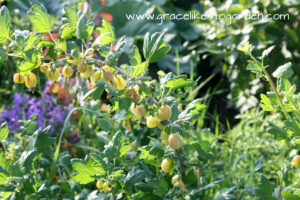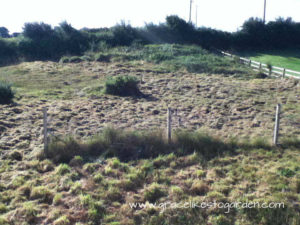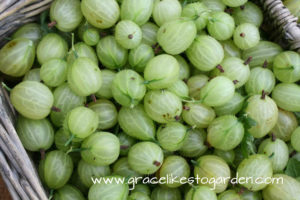 Growing gooseberries is something I started doing a few years ago.
Growing gooseberries is something I started doing a few years ago.
I began with two small bushes which I bought locally and each year they have both cropped.
I have only ever fed them with my own nettle tea which is very easy to make.
Before now I have never had enough fruit to make more than one or two pots of jam.
This year, however, has been the exception with an abundant harvest.
In fact, this year’s harvest has been so abundant that I have made more gooseberry jam than we can eat so there is plenty to spare for family and friends.
I have also given free berry picking rights to a good friend and there is more than enough for us all.
I always wanted gooseberries, and have great memories of my granny’s luscious soft fruit and jams when I visited her in Wicklow as a child.
What I have learned is that growing gooseberries is not difficult – once you have some soil.
GROWING GOOSEBERRIES WITH POOR SOIL
Therein lay the problem. The land here is Burren land, rocks, stones and very little soil. That was difficult.
The part of the garden we chose for the soft fruit had never been developed – see the picture below taken in 2013.
We had to clear away thick briar in order to access it without being strangled, tripped up or scratched to bits by the thick ropes of briar and their sharp thorns.
 I was warned that there was no soil but I imagined there must be some.
I was warned that there was no soil but I imagined there must be some.
But once the briar was cleared away there was no hiding from the fact that there was no soil.
Instead of soil, the ground is full of large limestone rocks and stones with only the occasional pocket of soil hidden in crevices between the rocks.
So before we could start growing gooseberries or any of our other berries we had to create soil.
I read a little bit about this problem in permaculture books and decided to loosely follow permaculture methods and create our own soil.
We did this by placing compostable waste in the specific areas into which we were going to plant.
We had a large rectangle of ground we were going to use for the soft fruit garden but it wasn’t practical to cover the entire space and we certainly didn’t have enough vegetable peelings from just us two.
So we decided where the beds would be, marked them out into shapes with stones and deposited our waste directly into these beds.
We covered the compostable waste with WET newspapers, WET cardboard and tons of seaweed.
I have capitalised WET because I made the mistake of placing dry newspapers and cardboard down one day only to see it flying around the air the very next day – we live in a very windy spot.
Being so close to the shore and having loads of seaweed available was great.
When the hens arrived they did their little dance on the beds and helped mix everything in. And, of course, they added their own special brand of manure.
 There will probably be permaculture purists or experts who will tell me I did this wrong.
There will probably be permaculture purists or experts who will tell me I did this wrong.
Maybe there are better ways but my simple method bore fruit (sorry couldn’t resist) and I only share what has worked for me. You can judge for yourself by the picture on the right.
So, if you want to create planting areas where there is no soil or poor soil, then I would highly recommend this method.
Use whatever compostable material you have available. If you can get horse manure then use that.
This method is not for the tidy garden brigade but if you don’t mind looking at a mess for a year then you will find this easy enough to do.
 We were able to start planting our soft fruit the following year and now have the whole rectangular area planted with soft fruit, including more raspberries than we can eat – and I do love raspberries.
We were able to start planting our soft fruit the following year and now have the whole rectangular area planted with soft fruit, including more raspberries than we can eat – and I do love raspberries.
This year’s harvest has brought more than we can use and so we are sharing with friends and neighbours.
I am hoping to entice more friends into coming and picking their own as well.
If not then the birds will have a fantastic feast and good luck to them.
Bye for now.
Grace
P.S. Do you have kids? If so, take a peek below before you go.
DO YOU WANT TO ENCOURAGE YOUR CHILDREN TO LOVE NATURE?
MAGGIE MANY CATS
Some of you will know that I am a writer as well as a gardener. I used to write for Ireland’s RTE 1 children’s radio series and I still love writing for children.
The Ballyyahoo series of children’s books is my favourite personal project.
My aim is to share my love of nature with children.
TAKE A WANDER AROUND BALLYYAHOO
Each book in the series is linked to the Ballyyahoo website with additional information and nature photographs.
There’s so much to love about nature – best of all it’s free!










Recent Comments